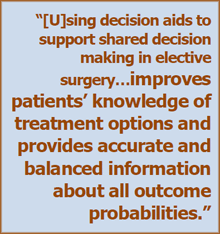Synopsis
Decision aids may help patients with knee and hip osteoarthritis make more informed, cost-effective treatment choices. In a large observational study, patients who received balanced information on the risks and benefits of orthopedic procedures had 26 percent fewer hip replacement surgeries, 38 percent fewer knee replacement surgeries, and 12 percent to 21 percent lower costs over a six-month period.
The Issue
 Total hip and knee replacements are among the most common orthopedic procedures performed and cost an estimated $15.6 billion annually. Because the decision to perform surgery often comes down to preferences, it is important that both patients and doctors have evidence-based information about the risks and benefits of the procedures. Decision aids that present balanced information about treatment options have been shown to increase patients' knowledge and improve participation in care choices, but less is known about whether these aids influence surgical rates or costs of care. A Commonwealth Fund–supported study measured decision aids' influence on care and identified the characteristics of patients who chose surgery and the factors that influenced treatment costs.
Total hip and knee replacements are among the most common orthopedic procedures performed and cost an estimated $15.6 billion annually. Because the decision to perform surgery often comes down to preferences, it is important that both patients and doctors have evidence-based information about the risks and benefits of the procedures. Decision aids that present balanced information about treatment options have been shown to increase patients' knowledge and improve participation in care choices, but less is known about whether these aids influence surgical rates or costs of care. A Commonwealth Fund–supported study measured decision aids' influence on care and identified the characteristics of patients who chose surgery and the factors that influenced treatment costs.
Key Findings
- After adjusting for age, severity of condition, and other factors, the rate of hip replacement surgery was 26 percent lower among patients who received decision aids. Patients who had hip replacement surgery were more likely to be older, to have had at least one appointment related to hip osteoarthritis in the past year, and to have had at least one prior large-joint injection.
- The rate of knee replacement surgeries was 38 percent lower among patients who received decision aids. Patients who had knee replacement surgery were more likely to be older and to have had prior appointments related to knee osteoarthritis in the past year, and less likely to have had knee X-ray or knee magnetic resonance imaging in the prior year.
- Costs were lower for patients with knee and hip osteoarthritis after decision aids were introduced. Among patients with hip osteoarthritis, costs were 21 percent lower. Costs for patients with knee osteoarthritis after decision aids were introduced were 12 percent lower.
Addressing the Problem
While the study establishes that decision aids may be useful in improving decision quality and patient education for patients with hip and knee osteoarthritis, more research is needed to determine whether these aids would have an impact on the treatment of other preference-sensitive health conditions, such as abnormal uterine bleeding, uterine fibroids, lumbar herniated disc, lumbar spinal stenosis, chronic stable angina, benign prostatic hyperplasia, early-stage prostate cancer, and early-stage breast cancer.
About the Study
The authors reported on changes in surgical rates and costs over six months following the start of a program to introduce decision aids for hip and knee osteoarthritis. The program was put in place by all orthopedic providers at Group Health, a health system covering more than 660,000 residents of Washington and Idaho. The study population included patients age 45 or older who were seen by an orthopedic provider over an 18-month period from January 2009 through mid-July 2010. Patients seen from January 2007 through July 2008 served as a control group. The decision aids were distributed to patients primarily in DVD and booklet format. Patients could also view the decision aids online.
The Bottom Line
The use of decision aids may reduce rates of elective surgery and lower costs, particularly when they are used for conditions in which treatment decisions are highly sensitive to both patients’ and physicians' preferences.


